English- INDIA Connecting the Nation! Satish Kumar

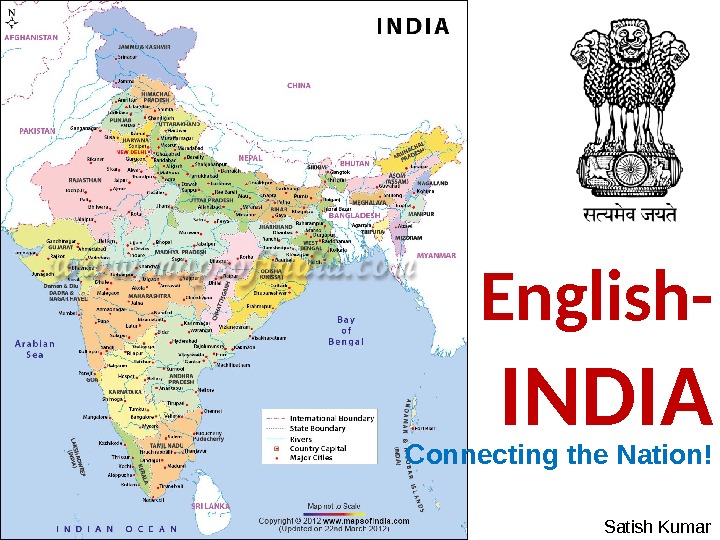
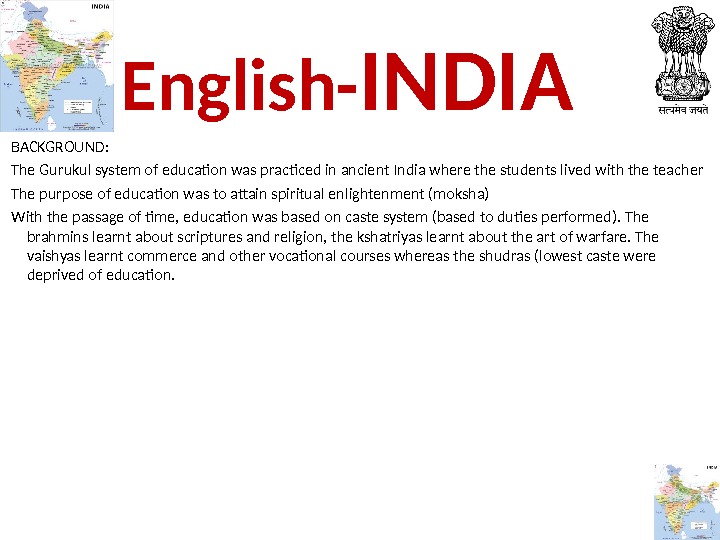
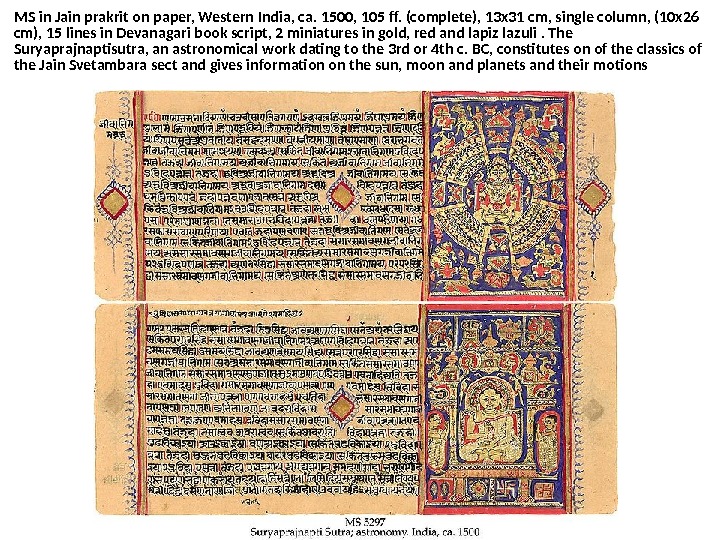
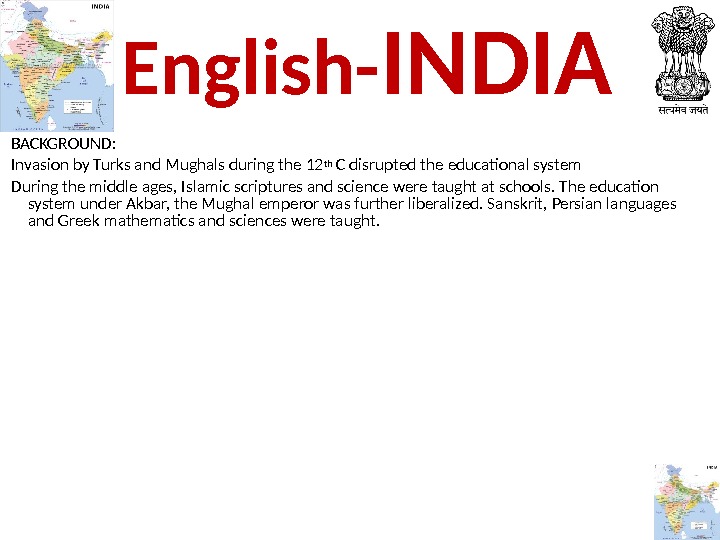
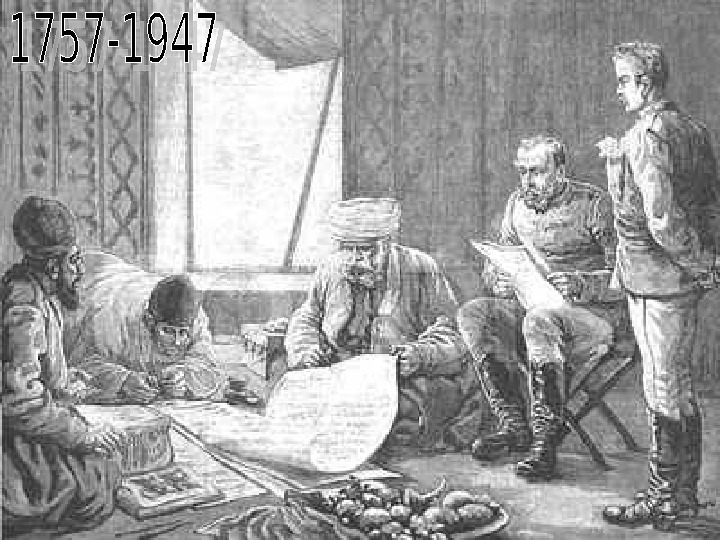
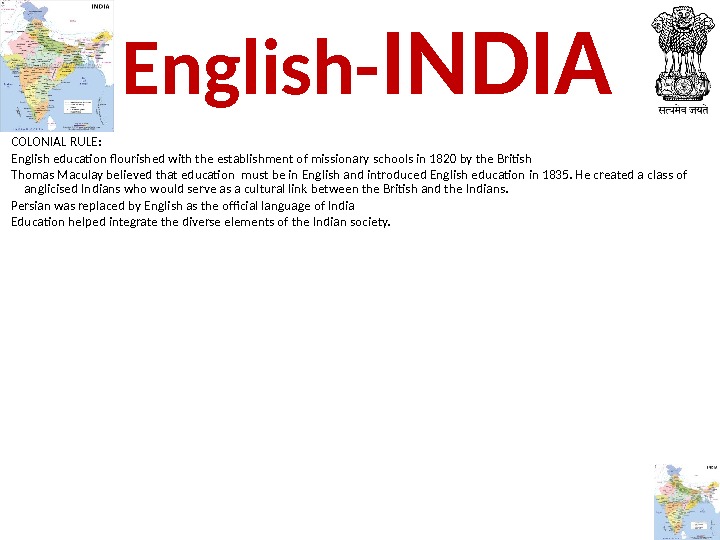
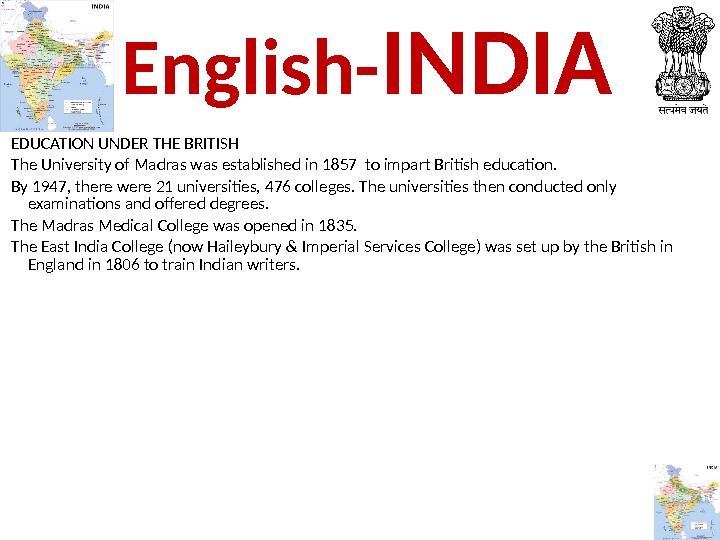
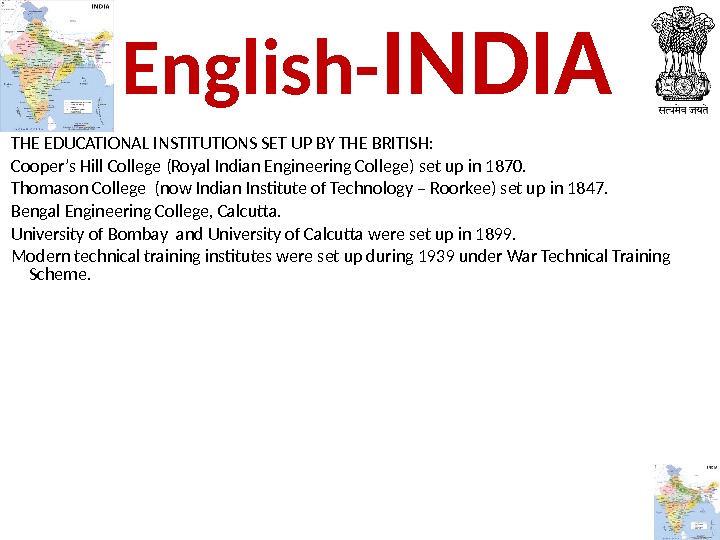
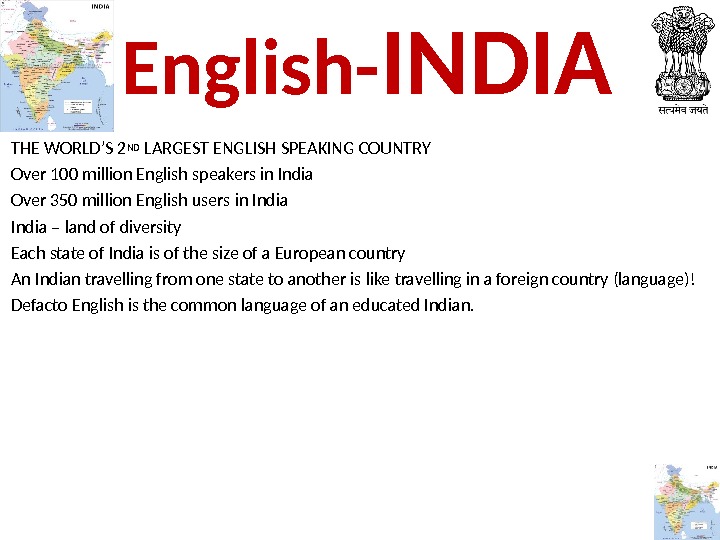
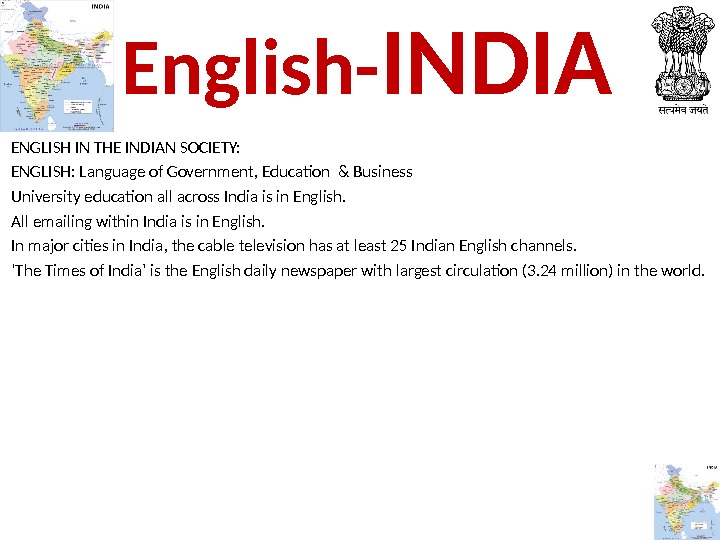
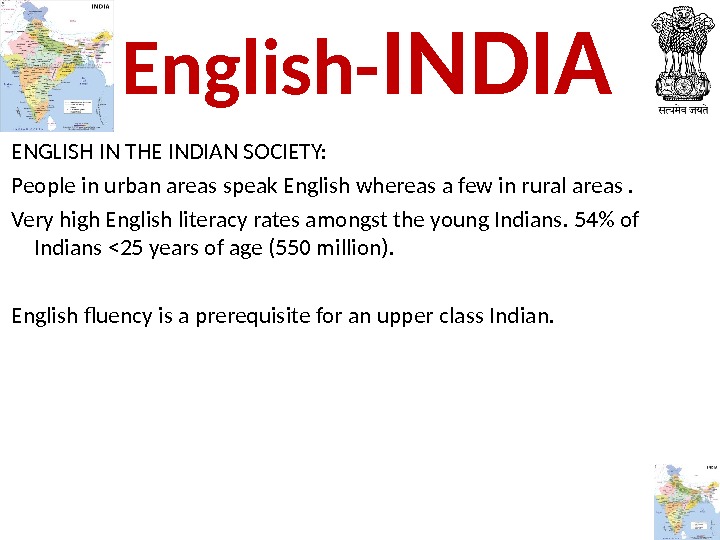
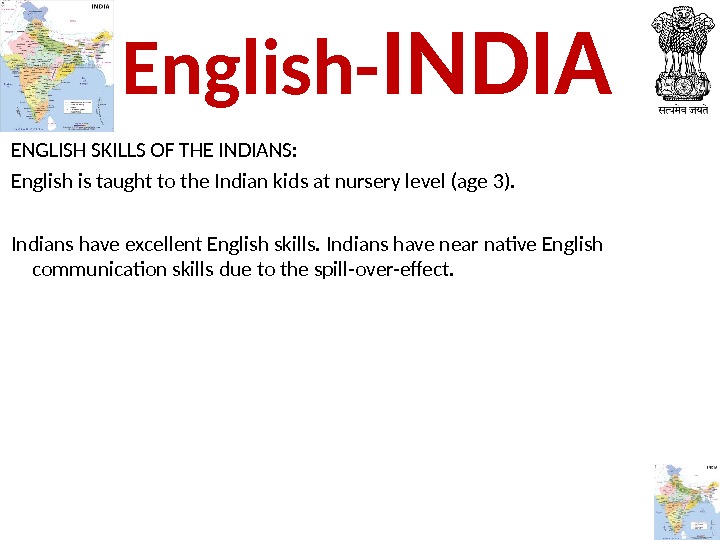
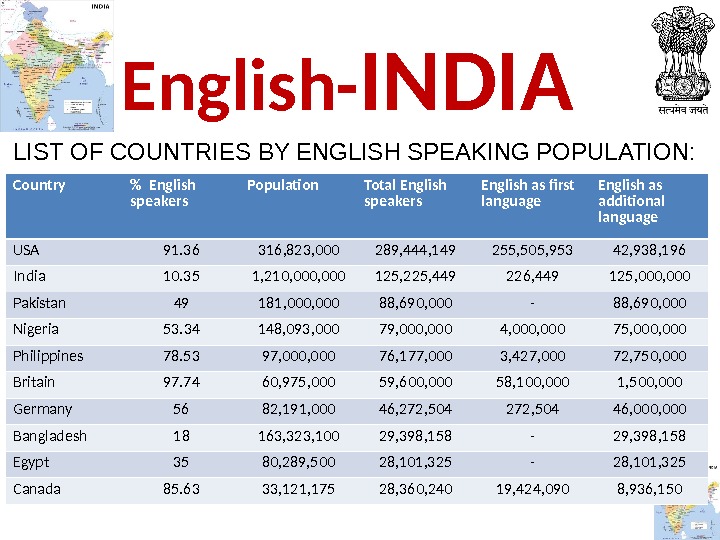
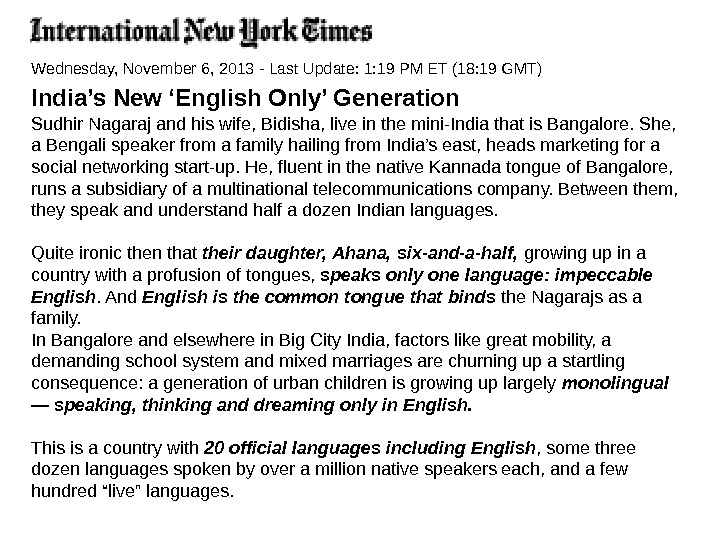
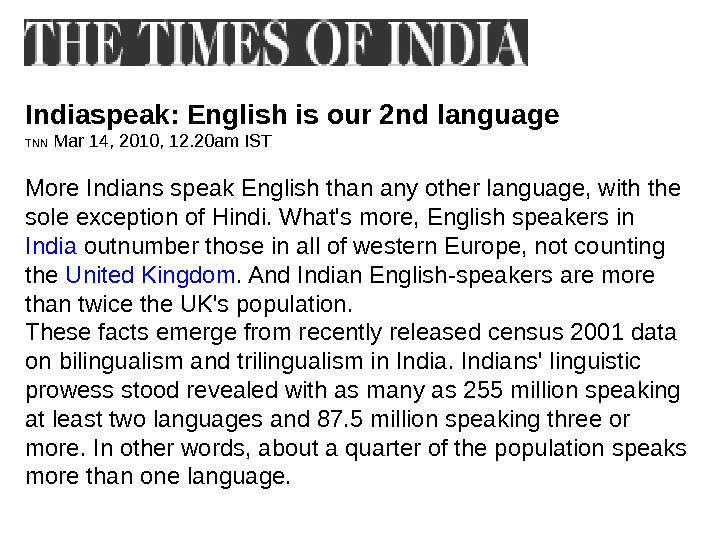
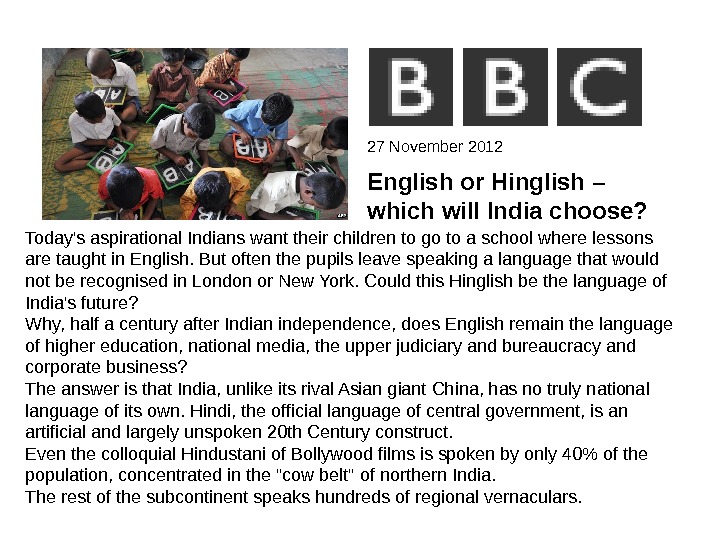
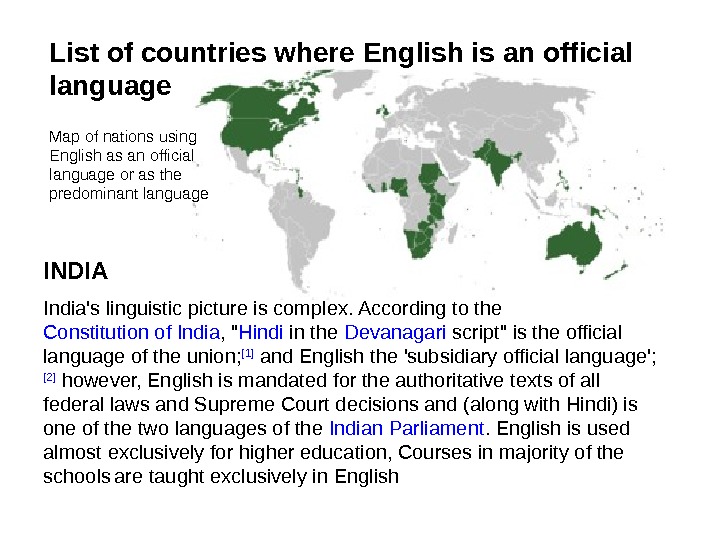
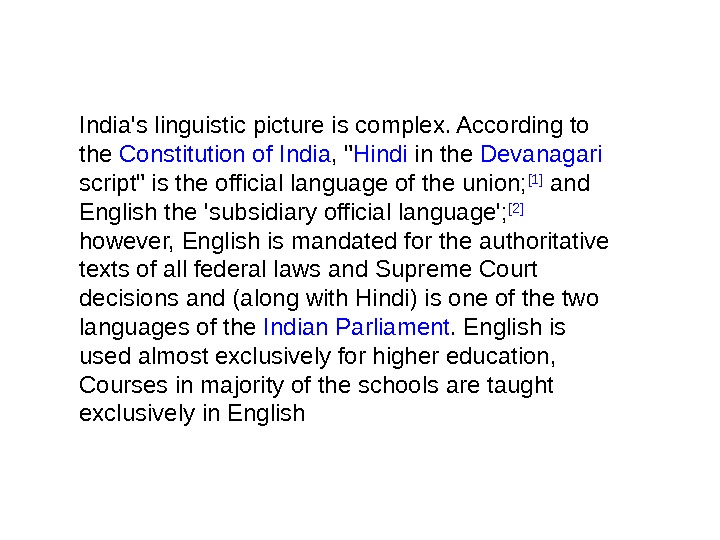

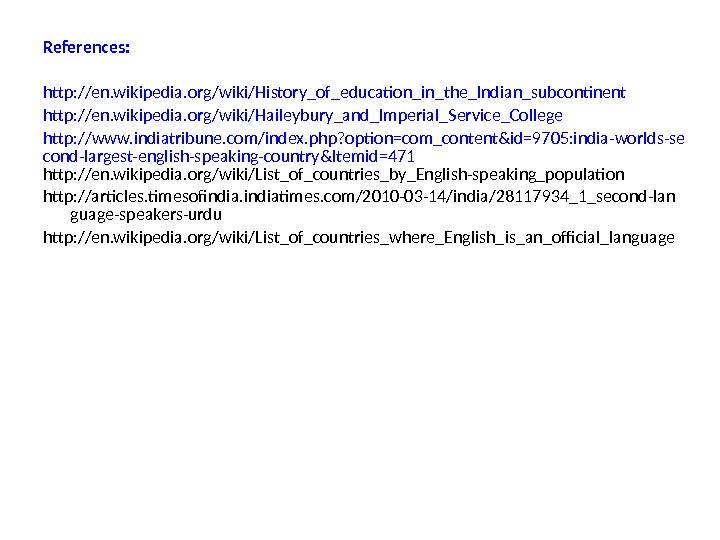
- Размер: 1.4 Mегабайта
- Количество слайдов: 20
Описание презентации English- INDIA Connecting the Nation! Satish Kumar по слайдам
 English- INDIA Connecting the Nation! Satish Kumar
English- INDIA Connecting the Nation! Satish Kumar
 BACKGROUND: The Gurukul system of education was practiced in ancient India where the students lived with the teacher The purpose of education was to attain spiritual enlightenment (moksha) With the passage of time, education was based on caste system (based to duties performed). The brahmins learnt about scriptures and religion, the kshatriyas learnt about the art of warfare. The vaishyas learnt commerce and other vocational courses whereas the shudras (lowest caste were deprived of education. English- INDI
BACKGROUND: The Gurukul system of education was practiced in ancient India where the students lived with the teacher The purpose of education was to attain spiritual enlightenment (moksha) With the passage of time, education was based on caste system (based to duties performed). The brahmins learnt about scriptures and religion, the kshatriyas learnt about the art of warfare. The vaishyas learnt commerce and other vocational courses whereas the shudras (lowest caste were deprived of education. English- INDI
 MS in Jain prakrit on paper, Western India, ca. 1500, 105 ff. (complete), 13 x 31 cm, single column, (10 x 26 cm), 15 lines in Devanagari book script, 2 miniatures in gold, red and lapiz lazuli. The Suryaprajnaptisutra, an astronomical work dating to the 3 rd or 4 th c. BC, constitutes on of the classics of the Jain Svetambara sect and gives information on the sun, moon and planets and their motions
MS in Jain prakrit on paper, Western India, ca. 1500, 105 ff. (complete), 13 x 31 cm, single column, (10 x 26 cm), 15 lines in Devanagari book script, 2 miniatures in gold, red and lapiz lazuli. The Suryaprajnaptisutra, an astronomical work dating to the 3 rd or 4 th c. BC, constitutes on of the classics of the Jain Svetambara sect and gives information on the sun, moon and planets and their motions
 BACKGROUND: Invasion by Turks and Mughals during the 12 th C disrupted the educational system During the middle ages, Islamic scriptures and science were taught at schools. The education system under Akbar, the Mughal emperor was further liberalized. Sanskrit, Persian languages and Greek mathematics and sciences were taught. English- INDI
BACKGROUND: Invasion by Turks and Mughals during the 12 th C disrupted the educational system During the middle ages, Islamic scriptures and science were taught at schools. The education system under Akbar, the Mughal emperor was further liberalized. Sanskrit, Persian languages and Greek mathematics and sciences were taught. English- INDI
 BRITISH IN INDIA: The It is disrespectful to address the elders by their name. It is advisable to address the elders as ‘sir’ or ‘madam’ with respect. One could address the youngsters by their names. INDIAN
BRITISH IN INDIA: The It is disrespectful to address the elders by their name. It is advisable to address the elders as ‘sir’ or ‘madam’ with respect. One could address the youngsters by their names. INDIAN
 COLONIAL RULE: English education flourished with the establishment of missionary schools in 1820 by the British Thomas Maculay believed that education must be in English and introduced English education in 1835. He created a class of anglicised Indians who would serve as a cultural link between the British and the Indians. Persian was replaced by English as the official language of India Education helped integrate the diverse elements of the Indian society. English- INDI
COLONIAL RULE: English education flourished with the establishment of missionary schools in 1820 by the British Thomas Maculay believed that education must be in English and introduced English education in 1835. He created a class of anglicised Indians who would serve as a cultural link between the British and the Indians. Persian was replaced by English as the official language of India Education helped integrate the diverse elements of the Indian society. English- INDI
 EDUCATION UNDER THE BRITISH The University of Madras was established in 1857 to impart British education. By 1947, there were 21 universities, 476 colleges. The universities then conducted only examinations and offered degrees. The Madras Medical College was opened in 1835. The East India College (now Haileybury & Imperial Services College) was set up by the British in England in 1806 to train Indian writers. English- INDI
EDUCATION UNDER THE BRITISH The University of Madras was established in 1857 to impart British education. By 1947, there were 21 universities, 476 colleges. The universities then conducted only examinations and offered degrees. The Madras Medical College was opened in 1835. The East India College (now Haileybury & Imperial Services College) was set up by the British in England in 1806 to train Indian writers. English- INDI
 THE EDUCATIONAL INSTITUTIONS SET UP BY THE BRITISH: Cooper’s Hill College (Royal Indian Engineering College) set up in 1870. Thomason College (now Indian Institute of Technology – Roorkee) set up in 1847. Bengal Engineering College, Calcutta. University of Bombay and University of Calcutta were set up in 1899. Modern technical training institutes were set up during 1939 under War Technical Training Scheme. 8 English- INDI
THE EDUCATIONAL INSTITUTIONS SET UP BY THE BRITISH: Cooper’s Hill College (Royal Indian Engineering College) set up in 1870. Thomason College (now Indian Institute of Technology – Roorkee) set up in 1847. Bengal Engineering College, Calcutta. University of Bombay and University of Calcutta were set up in 1899. Modern technical training institutes were set up during 1939 under War Technical Training Scheme. 8 English- INDI
 THE WORLD’S 2 ND LARGEST ENGLISH SPEAKING COUNTRY Over 100 million English speakers in India Over 350 million English users in India – land of diversity Each state of India is of the size of a European country An Indian travelling from one state to another is like travelling in a foreign country (language)! Defacto English is the common language of an educated Indian. 9 English- INDI
THE WORLD’S 2 ND LARGEST ENGLISH SPEAKING COUNTRY Over 100 million English speakers in India Over 350 million English users in India – land of diversity Each state of India is of the size of a European country An Indian travelling from one state to another is like travelling in a foreign country (language)! Defacto English is the common language of an educated Indian. 9 English- INDI
 ENGLISH IN THE INDIAN SOCIETY: ENGLISH: Language of Government, Education & Business University education all across India is in English. All emailing within India is in English. In major cities in India, the cable television has at least 25 Indian English channels. ‘ The Times of India’ is the English daily newspaper with largest circulation (3. 24 million) in the world. 10 English- INDI
ENGLISH IN THE INDIAN SOCIETY: ENGLISH: Language of Government, Education & Business University education all across India is in English. All emailing within India is in English. In major cities in India, the cable television has at least 25 Indian English channels. ‘ The Times of India’ is the English daily newspaper with largest circulation (3. 24 million) in the world. 10 English- INDI
 ENGLISH IN THE INDIAN SOCIETY: People in urban areas speak English whereas a few in rural areas. Very high English literacy rates amongst the young Indians. 54% of Indians <25 years of age (550 million). English fluency is a prerequisite for an upper class Indian. 11 English- INDI
ENGLISH IN THE INDIAN SOCIETY: People in urban areas speak English whereas a few in rural areas. Very high English literacy rates amongst the young Indians. 54% of Indians <25 years of age (550 million). English fluency is a prerequisite for an upper class Indian. 11 English- INDI
 ENGLISH SKILLS OF THE INDIANS: English is taught to the Indian kids at nursery level (age 3). Indians have excellent English skills. Indians have near native English communication skills due to the spill-over-effect. 12 English- INDI
ENGLISH SKILLS OF THE INDIANS: English is taught to the Indian kids at nursery level (age 3). Indians have excellent English skills. Indians have near native English communication skills due to the spill-over-effect. 12 English- INDI
 13 Country % English speakers Population Total English speakers English as first language English as additional language USA 91. 36 316, 823, 000 289, 444, 149 255, 505, 953 42, 938, 196 India 10. 35 1, 210, 000 125, 225, 449 226, 449 125, 000 Pakistan 49 181, 000 88, 690, 000 — 88, 690, 000 Nigeria 53. 34 148, 093, 000 79, 000 4, 000 75, 000 Philippines 78. 53 97, 000 76, 177, 000 3, 427, 000 72, 750, 000 Britain 97. 74 60, 975, 000 59, 600, 000 58, 100, 000 1, 500, 000 Germany 56 82, 191, 000 46, 272, 504 46, 000 Bangladesh 18 163, 323, 100 29, 398, 158 — 29, 398, 158 Egypt 35 80, 289, 500 28, 101, 325 — 28, 101, 325 Canada 85. 63 33, 121, 175 28, 360, 240 19, 424, 090 8, 936, 150 LIST OF COUNTRIES BY ENGLISH SPEAKING POPULATION: English- INDI
13 Country % English speakers Population Total English speakers English as first language English as additional language USA 91. 36 316, 823, 000 289, 444, 149 255, 505, 953 42, 938, 196 India 10. 35 1, 210, 000 125, 225, 449 226, 449 125, 000 Pakistan 49 181, 000 88, 690, 000 — 88, 690, 000 Nigeria 53. 34 148, 093, 000 79, 000 4, 000 75, 000 Philippines 78. 53 97, 000 76, 177, 000 3, 427, 000 72, 750, 000 Britain 97. 74 60, 975, 000 59, 600, 000 58, 100, 000 1, 500, 000 Germany 56 82, 191, 000 46, 272, 504 46, 000 Bangladesh 18 163, 323, 100 29, 398, 158 — 29, 398, 158 Egypt 35 80, 289, 500 28, 101, 325 — 28, 101, 325 Canada 85. 63 33, 121, 175 28, 360, 240 19, 424, 090 8, 936, 150 LIST OF COUNTRIES BY ENGLISH SPEAKING POPULATION: English- INDI
 Sudhir Nagaraj and his wife, Bidisha, live in the mini-India that is Bangalore. She, a Bengali speaker from a family hailing from India’s east, heads marketing for a social networking start-up. He, fluent in the native Kannada tongue of Bangalore, runs a subsidiary of a multinational telecommunications company. Between them, they speak and understand half a dozen Indian languages. Quite ironic then that their daughter, Ahana, six-and-a-half, growing up in a country with a profusion of tongues, speaks only one language: impeccable English. And English is the common tongue that binds the Nagarajs as a family. In Bangalore and elsewhere in Big City India, factors like great mobility, a demanding school system and mixed marriages are churning up a startling consequence: a generation of urban children is growing up largely monolingual — speaking, thinking and dreaming only in English. This is a country with 20 official languages including English , some three dozen languages spoken by over a million native speakers each, and a few hundred “live” languages. India’s New ‘English Only’ Generation. Wednesday, November 6, 2013 — Last Update: 1: 19 PM ET (18: 19 GMT)
Sudhir Nagaraj and his wife, Bidisha, live in the mini-India that is Bangalore. She, a Bengali speaker from a family hailing from India’s east, heads marketing for a social networking start-up. He, fluent in the native Kannada tongue of Bangalore, runs a subsidiary of a multinational telecommunications company. Between them, they speak and understand half a dozen Indian languages. Quite ironic then that their daughter, Ahana, six-and-a-half, growing up in a country with a profusion of tongues, speaks only one language: impeccable English. And English is the common tongue that binds the Nagarajs as a family. In Bangalore and elsewhere in Big City India, factors like great mobility, a demanding school system and mixed marriages are churning up a startling consequence: a generation of urban children is growing up largely monolingual — speaking, thinking and dreaming only in English. This is a country with 20 official languages including English , some three dozen languages spoken by over a million native speakers each, and a few hundred “live” languages. India’s New ‘English Only’ Generation. Wednesday, November 6, 2013 — Last Update: 1: 19 PM ET (18: 19 GMT)
 Indiaspeak: English is our 2 nd language TNN Mar 14, 2010, 12. 20 am IST More Indians speak English than any other language, with the sole exception of Hindi. What’s more, English speakers in India outnumber those in all of western Europe, not counting the United Kingdom. And Indian English-speakers are more than twice the UK’s population. These facts emerge from recently released census 2001 data on bilingualism and trilingualism in Indians’ linguistic prowess stood revealed with as many as 255 million speaking at least two languages and 87. 5 million speaking three or more. In other words, about a quarter of the population speaks more than one language.
Indiaspeak: English is our 2 nd language TNN Mar 14, 2010, 12. 20 am IST More Indians speak English than any other language, with the sole exception of Hindi. What’s more, English speakers in India outnumber those in all of western Europe, not counting the United Kingdom. And Indian English-speakers are more than twice the UK’s population. These facts emerge from recently released census 2001 data on bilingualism and trilingualism in Indians’ linguistic prowess stood revealed with as many as 255 million speaking at least two languages and 87. 5 million speaking three or more. In other words, about a quarter of the population speaks more than one language.
 Today’s aspirational Indians want their children to go to a school where lessons are taught in English. But often the pupils leave speaking a language that would not be recognised in London or New York. Could this Hinglish be the language of India’s future? Why, half a century after Indian independence, does English remain the language of higher education, national media, the upper judiciary and bureaucracy and corporate business? The answer is that India, unlike its rival Asian giant China, has no truly national language of its own. Hindi, the official language of central government, is an artificial and largely unspoken 20 th Century construct. Even the colloquial Hindustani of Bollywood films is spoken by only 40% of the population, concentrated in the «cow belt» of northern India. The rest of the subcontinent speaks hundreds of regional vernaculars. English or Hinglish – which will India choose? 27 November
Today’s aspirational Indians want their children to go to a school where lessons are taught in English. But often the pupils leave speaking a language that would not be recognised in London or New York. Could this Hinglish be the language of India’s future? Why, half a century after Indian independence, does English remain the language of higher education, national media, the upper judiciary and bureaucracy and corporate business? The answer is that India, unlike its rival Asian giant China, has no truly national language of its own. Hindi, the official language of central government, is an artificial and largely unspoken 20 th Century construct. Even the colloquial Hindustani of Bollywood films is spoken by only 40% of the population, concentrated in the «cow belt» of northern India. The rest of the subcontinent speaks hundreds of regional vernaculars. English or Hinglish – which will India choose? 27 November
 Map of nations using English as an official language or as the predominant language India’s linguistic picture is complex. According to the Constitution of India , » Hindi in the Devanagari script» is the official language of the union; [1] and English the ‘subsidiary official language’; [2] however, English is mandated for the authoritative texts of all federal laws and Supreme Court decisions and (along with Hindi) is one of the two languages of the Indian Parliament. English is used almost exclusively for higher education, Courses in majority of the schools are taught exclusively in English. List of countries where English is an official language INDI
Map of nations using English as an official language or as the predominant language India’s linguistic picture is complex. According to the Constitution of India , » Hindi in the Devanagari script» is the official language of the union; [1] and English the ‘subsidiary official language’; [2] however, English is mandated for the authoritative texts of all federal laws and Supreme Court decisions and (along with Hindi) is one of the two languages of the Indian Parliament. English is used almost exclusively for higher education, Courses in majority of the schools are taught exclusively in English. List of countries where English is an official language INDI
 India’s linguistic picture is complex. According to the Constitution of India , » Hindi in the Devanagari script» is the official language of the union; [1] and English the ‘subsidiary official language’; [2] however, English is mandated for the authoritative texts of all federal laws and Supreme Court decisions and (along with Hindi) is one of the two languages of the Indian Parliament. English is used almost exclusively for higher education, Courses in majority of the schools are taught exclusively in English
India’s linguistic picture is complex. According to the Constitution of India , » Hindi in the Devanagari script» is the official language of the union; [1] and English the ‘subsidiary official language’; [2] however, English is mandated for the authoritative texts of all federal laws and Supreme Court decisions and (along with Hindi) is one of the two languages of the Indian Parliament. English is used almost exclusively for higher education, Courses in majority of the schools are taught exclusively in English

 References: http: //en. wikipedia. org/wiki/History_of_education_in_the_Indian_subcontinent http: //en. wikipedia. org/wiki/Haileybury_and_Imperial_Service_College http: //www. indiatribune. com/index. php? option=com_content&id=9705: india-worlds-se cond-largest-english-speaking-country&Itemid=471 http: //en. wikipedia. org/wiki/List_of_countries_by_English-speaking_population http: //articles. timesofindiatimes. com/2010 -03 -14/india/28117934_1_second-lan guage-speakers-urdu http: //en. wikipedia. org/wiki/List_of_countries_where_English_is_an_official_language
References: http: //en. wikipedia. org/wiki/History_of_education_in_the_Indian_subcontinent http: //en. wikipedia. org/wiki/Haileybury_and_Imperial_Service_College http: //www. indiatribune. com/index. php? option=com_content&id=9705: india-worlds-se cond-largest-english-speaking-country&Itemid=471 http: //en. wikipedia. org/wiki/List_of_countries_by_English-speaking_population http: //articles. timesofindiatimes. com/2010 -03 -14/india/28117934_1_second-lan guage-speakers-urdu http: //en. wikipedia. org/wiki/List_of_countries_where_English_is_an_official_language

